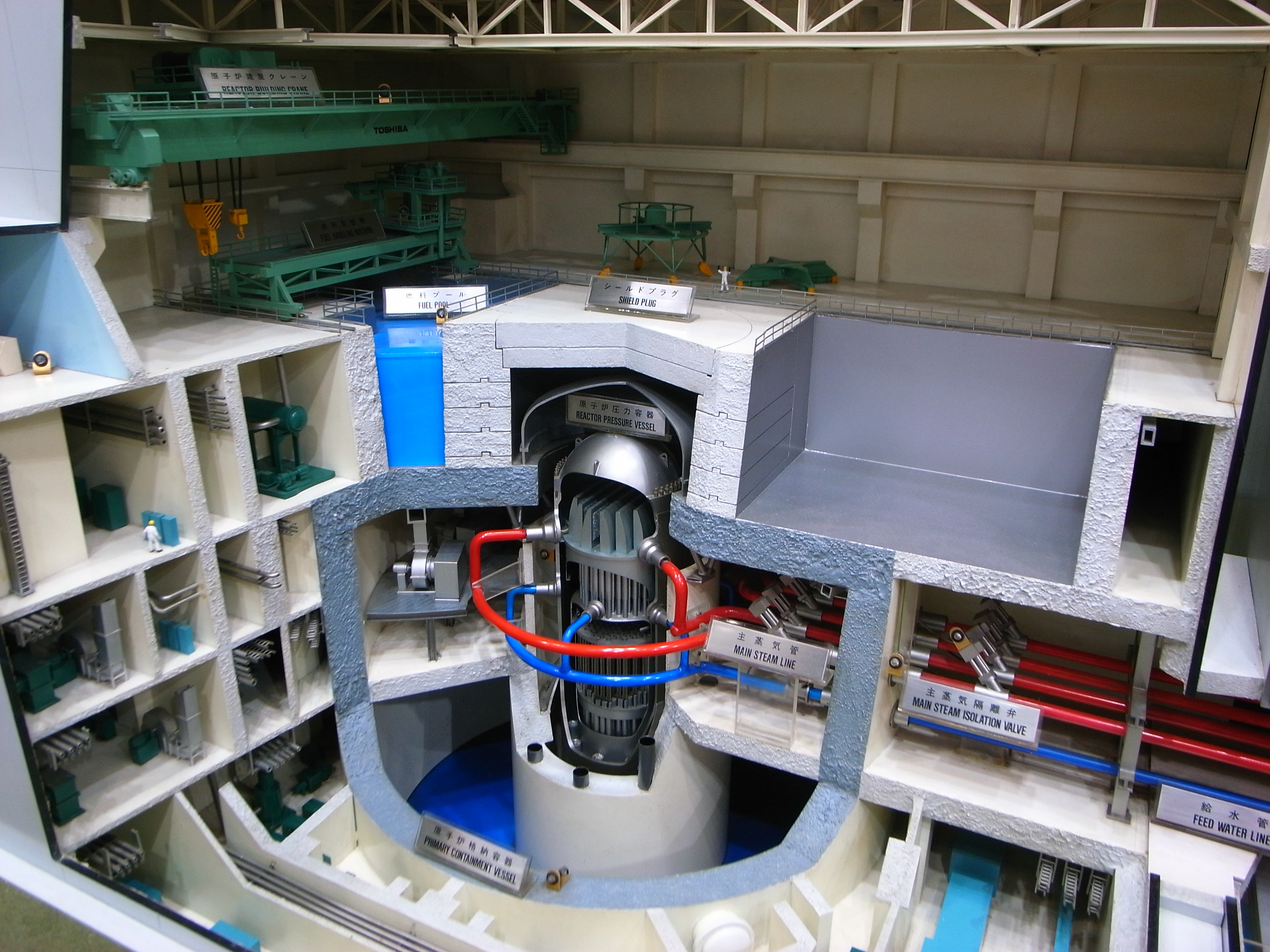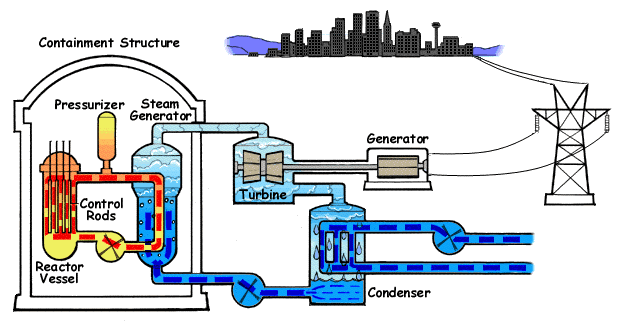|
VVER 440
The water-water energetic reactor (WWER), or VVER (from ) is a series of pressurized water reactor designs originally developed in the Soviet Union, and now Russia, by OKB Gidropress. The idea of such a reactor was proposed at the Kurchatov Institute by Savely Moiseevich Feinberg. VVER were originally developed before the 1970s, and have been continually updated. They were one of the initial reactors developed by the USSR, the other being the infamous RBMK. As a result, the name VVER is associated with a wide variety of reactor designs spanning from generation I reactors to modern generation III+ reactor designs. Power output ranges from 70 to 1300 MWe, with designs of up to 1700 MWe in development. The first prototype VVER-210 was built at the Novovoronezh Nuclear Power Plant. VVER power stations have been installed in Russia, Ukraine, Belarus, Armenia, China, the Czech Republic, Finland, Hungary, Slovakia, Bulgaria, India, and Iran. Countries that are planning to introduce VVER r ... [...More Info...] [...Related Items...] OR: [Wikipedia] [Google] [Baidu] |
Light-water Reactor
The light-water reactor (LWR) is a type of thermal-neutron reactor that uses normal water, as opposed to heavy water, as both its coolant and neutron moderator; furthermore a solid form of fissile elements is used as fuel. Thermal-neutron reactors are the most common type of nuclear reactor, and light-water reactors are the most common type of thermal-neutron reactor. There are three varieties of light-water reactors: the pressurized water reactor (PWR), the boiling water reactor (BWR), and (most designs of) the supercritical water reactor (SCWR). History Early concepts and experiments After the discoveries of fission, moderation and of the theoretical possibility of a nuclear chain reaction, early experimental results rapidly showed that natural uranium could only undergo a sustained chain reaction using graphite or heavy water as a moderator. While the world's first reactors ( CP-1, X10 etc.) were successfully reaching criticality, uranium enrichment began to develop ... [...More Info...] [...Related Items...] OR: [Wikipedia] [Google] [Baidu] |
Generation III+ Reactor
Generation III reactors, or Gen III reactors, are a class of nuclear reactors designed to succeed Generation II reactors, incorporating evolutionary improvements in design. These include improved fuel technology, higher thermal efficiency, significantly enhanced safety systems (including passive nuclear safety), and standardized designs intended to reduce maintenance and capital costs. They are promoted by the Generation IV International Forum (GIF). The first Generation III reactors to begin operation were Kashiwazaki 6 and 7 advanced boiling water reactors (ABWRs) in 1996 and 1997. From 2012, both have been shut down due to a less permissive political environment in the wake of the Fukushima nuclear accident. Due to the prolonged period of stagnation in the construction of new reactors and the continued (albeit declining) popularity of Generation II/II+ designs in new construction, relatively few third generation reactors have been built. Overview The older Gen II reactors ... [...More Info...] [...Related Items...] OR: [Wikipedia] [Google] [Baidu] |
Pressurised Water Reactor
A pressurized water reactor (PWR) is a type of light-water nuclear reactor. PWRs constitute the large majority of the world's nuclear power plants (with notable exceptions being the UK, Japan, India and Canada). In a PWR, water is used both as a neutron moderator and as coolant fluid for the reactor core. In the core, water is heated by the energy released by the fission of atoms contained in the fuel. Using very high pressure (around 155 bar: 2250 psi) ensures that the water stays in a liquid state. The heated water then flows to a steam generator, where it transfers its thermal energy to the water of a secondary cycle kept at a lower pressure which allows it to vaporize. The resulting steam then drives steam turbines linked to an electric generator. A boiling water reactor (BWR) by contrast does not maintain such a high pressure in the primary cycle and the water thus vaporizes inside of the reactor pressure vessel (RPV) before being sent to the turbine. Most PWR designs ... [...More Info...] [...Related Items...] OR: [Wikipedia] [Google] [Baidu] |
Generation III Reactor
Generation III reactors, or Gen III reactors, are a class of nuclear reactors designed to succeed Generation II reactors, incorporating evolutionary improvements in design. These include improved fuel technology, higher thermal efficiency, significantly enhanced safety systems (including passive nuclear safety), and standardized designs intended to reduce maintenance and capital costs. They are promoted by the Generation IV International Forum (GIF). The first Generation III reactors to begin operation were Kashiwazaki 6 and 7 advanced boiling water reactors (ABWRs) in 1996 and 1997. From 2012, both have been shut down due to a less permissive political environment in the wake of the Fukushima nuclear accident. Due to the prolonged period of stagnation in the construction of new reactors and the continued (albeit declining) popularity of Generation II/II+ designs in new construction, relatively few third generation reactors have been built. Overview The older Gen II reactors ... [...More Info...] [...Related Items...] OR: [Wikipedia] [Google] [Baidu] |
Emergency Core Cooling System
The three primary objectives of nuclear reactor safety systems as defined by the U.S. Nuclear Regulatory Commission are to shut down the reactor, maintain it in a shutdown condition and prevent the release of radioactive material. Reactor protection system (RPS) A reactor protection system is designed to immediately terminate the nuclear reaction. By breaking the nuclear chain reaction, the source of heat is eliminated. Other systems can then be used to remove decay heat from the core. All nuclear plants have some form of reactor protection system. Control rods Control rods are a series of rods that can be quickly inserted into the reactor core to absorb neutrons and rapidly terminate the nuclear reaction. They are typically composed of actinides, lanthanides, transition metals, and boron, in various alloys with structural backing such as steel. In addition to being neutron absorbent, the alloys used also are required to have at least a low coefficient of thermal expansion so ... [...More Info...] [...Related Items...] OR: [Wikipedia] [Google] [Baidu] |
Containment Building
A containment building is a reinforced steel, concrete or lead structure enclosing a nuclear reactor. It is designed, in any emergency, to contain the escape of radioactive steam or gas to a maximum pressure in the range of . The containment is the fourth and final barrier to radioactive release (part of a nuclear reactor's defence in depth strategy), the first being the fuel ceramic itself, the second being the metal fuel cladding tubes, the third being the reactor vessel and coolant system. Each nuclear plant in the United States is designed to withstand certain conditions which are spelled out as "Design Basis Accidents" in the Final Safety Analysis Report (FSAR). The FSAR is available for public viewing, usually at a public library near the nuclear plant. The containment building itself is typically an airtight steel structure enclosing the reactor, normally sealed off from the outside atmosphere. The steel is either free-standing or attached to the concrete missile shiel ... [...More Info...] [...Related Items...] OR: [Wikipedia] [Google] [Baidu] |
Auxiliary Feedwater
Auxiliary feedwater is a backup water supply system found in pressurized water reactor nuclear power plants (PWRs). This system, sometimes known as emergency feedwater, can be used to cool the reactor, if normal feedwater to the steam generators fails to work. It works by pumping water to the steam generators from reserve tanks or a larger body of water (e.g. lake, river, or ocean) to remove decay heat from the reactor by dumping non-radioactive steam to atmosphere or using this steam to drive turbine driven auxiliary feedwater pump(s). The auxiliary feedwater system in PWRs are often equipped with ''motor driven'' aux feedwater pumps, and, as an additional measure, ''turbine driven'' aux feedwater pump that is driven not by electricity but by steam generated by decay heat removal from the normal secondary side steam circuit of the plant. The typical steam turbine used in the aux feedwater systems are the “solid wheel” or “water wheel” Terry Steam Turbines manufactured by t ... [...More Info...] [...Related Items...] OR: [Wikipedia] [Google] [Baidu] |
Nuclear Safety
Nuclear safety is defined by the International Atomic Energy Agency (IAEA) as "The achievement of proper operating conditions, prevention of accidents or mitigation of accident consequences, resulting in protection of workers, the public and the environment from undue Ionizing radiation, radiation hazards". The IAEA defines nuclear security as "The prevention and detection of and response to, theft, sabotage, unauthorized access, illegal transfer or other malicious acts involving nuclear materials, other radioactive substances or their associated facilities". This covers nuclear power plants and all other nuclear facilities, the transportation of nuclear materials, and the use and storage of nuclear materials for medical, power, industry, and military uses. The Nuclear power, nuclear power industry has improved the safety and performance of Nuclear reactor, reactors, and has proposed new and safer reactor designs. However, a perfect safety cannot be guaranteed. Potential sources ... [...More Info...] [...Related Items...] OR: [Wikipedia] [Google] [Baidu] |
Steam Generator (nuclear Power)
A steam generator (aka nuclear steam raising plant ('NSRP')) is a heat exchanger used to convert water into steam from heat produced in a nuclear reactor core. It is used in pressurized water reactors (PWRs), between the primary and secondary coolant loops. It is also used in liquid metal cooled reactors (LMRs), pressurized heavy-water reactors (PHWRs), and gas-cooled reactors (GCRs). In typical PWR designs, the primary coolant is high-purity water, kept under high pressure so it cannot boil. This primary coolant is pumped through the reactor core where it absorbs heat from the fuel rods. It then passes through the steam generator, where it transfers its heat (via conduction through metal) to lower-pressure water which is allowed to boil. Purpose Unlike PWRs, boiling water reactors (BWRs) do not use steam generators. The primary coolant is allowed to boil directly in the reactor core, and the steam is simply passed through a steam turbine. While theoretically simple, this has a ... [...More Info...] [...Related Items...] OR: [Wikipedia] [Google] [Baidu] |
Coolant
A coolant is a substance, typically liquid, that is used to reduce or regulate the temperature of a system. An ideal coolant has high thermal capacity, low viscosity, is low-cost, non-toxic, chemically inert and neither causes nor promotes corrosion of the cooling system. Some applications also require the coolant to be an electrical insulator. While the term "coolant" is commonly used in automotive and HVAC applications, in industrial processing heat-transfer fluid is one technical term more often used in high temperature as well as low-temperature manufacturing applications. The term also covers cutting fluids. Industrial cutting fluid has broadly been classified as water-soluble coolant and neat cutting fluid. Water-soluble coolant is oil in water emulsion. It has varying oil content from nil oil (synthetic coolant). This coolant can either keep its phase and stay liquid or gaseous, or can undergo a phase transition, with the latent heat adding to the cooling efficiency. ... [...More Info...] [...Related Items...] OR: [Wikipedia] [Google] [Baidu] |







